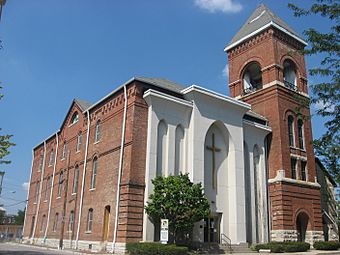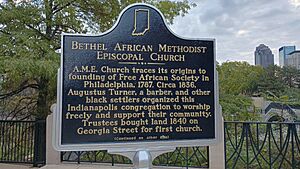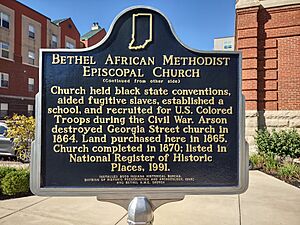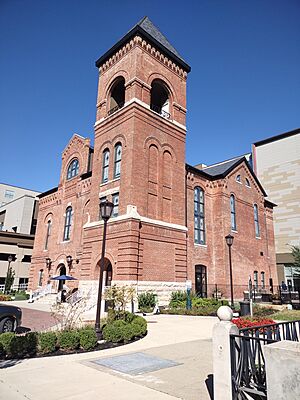Bethel A.M.E. Church (Indianapolis, Indiana) facts for kids
Quick facts for kids |
|
|
Bethel A. M. E. Church
|
|

The church building's exterior, 2011
|
|
| Location | 414 W. Vermont St., Indianapolis, Indiana |
|---|---|
| Area | less than one acre |
| Built | 1869 |
| Architect | Adam Busch |
| Architectural style | Modern Movement, Romanesque, Post Modern |
| NRHP reference No. | 91000269 |
| Added to NRHP | March 21, 1991 |
The Bethel A.M.E. Church is a very old and important church in Indianapolis, Indiana. It was also called Indianapolis Station or the Vermont Street Church when it was first built. This church is part of the African Methodist Episcopal Church, which is a Christian church started by African Americans.
The Bethel A.M.E. Church began in 1836, making it the oldest African American church group in Indianapolis. The church building on West Vermont Street was built in 1869. In 1991, it was added to the National Register of Historic Places, which lists important historical sites.
The area around the church used to be a main part of the African American community in downtown Indianapolis. After World War II, the neighborhood changed a lot. New hotels, apartments, offices, museums, and the Indiana University–Purdue University at Indianapolis campus were built.
In 2016, the church building was getting old and needed many repairs. The church group decided to sell it. The old building became part of a new hotel. The Bethel A.M.E. Church group then built a new place to worship at 6417 Zionsville Road in Pike Township, in northwest Indianapolis.
The Bethel A.M.E. Church has always helped the African American community in the city. It was very active in the movement to end slavery before the American Civil War. It also helped the Underground Railroad, which was a secret network that helped enslaved people escape to Canada. The church also focused on education and helping people in the community.
Bethel A.M.E. Church was like a "mother church" to other AME churches in Indiana. It was also a public meeting place in Indianapolis for people who wanted to make social changes. Important groups like the National Association for the Advancement of Colored People and the Indiana State Federation of Colored Women's Clubs were started at the Vermont Street church in the early 1900s.
Contents
History of Bethel A.M.E. Church
Indianapolis has been home to several African Methodist Episcopal Church groups. But Bethel A.M.E. Church is the oldest African American church group in the city. It started in 1836 as Indianapolis Station. By 1869, it was known as Bethel A.M.E. Church.
How the Church Began
In 1836, a local barber named Augustus Turner started a small group of African American Methodists. They first met in Turner's log cabin on Georgia Street. In 1841, they built a new church building on Georgia Street.
The group wanted to join the African Methodist Episcopal Church. William Paul Quinn, an AME minister from Cincinnati, Ohio, helped them. He later became an AME bishop. Quinn was the first AME minister to serve the Indianapolis Station. He also helped them become part of the AME Church's Western Circuit.
Elisha Weaver became the church's first full-time minister in 1850. The group officially became Bethel A.M.E. Church in the late 1860s. Even though the church grew and helped more people, it often had money problems in its early years.
The Georgia Street Church Building
In 1841, the church group built its first church on Georgia Street. It was a small, wooden building. They used this building until 1857. Then, they bought the first Christ Church building from the city's Episcopal group. The Episcopal church was building a new stone church.
The AME group moved the small wooden church to their land on Georgia Street. However, this church was destroyed by fire in 1862. Many people believe that the church was burned by people who supported slavery. This was because Bethel A.M.E. Church openly supported ending slavery and helped the Underground Railroad.
The church group raised money and rebuilt the wooden church in 1867. This new building was used until their brick church on West Vermont Street was built in 1868–69. The group sold some land they owned for $3,000. They used this money to buy new land for $5,000 on West Vermont Street. This new land became the site for their next church.
The Vermont Street Church Building
The West Vermont Street area, in downtown Indianapolis, has always been a central part of the African American community. This neighborhood had homes, shops, and businesses. In 1867, the church group hired Adam Busch to build a new brick church on their West Vermont Street land. The church was planned to cost $10,400.
By 1869, the building was only partly finished, but the group moved into the new church at 414 West Vermont Street. They officially became Bethel A.M.E. Church. To finish building the church, the Bethel group sold or borrowed money against other property they owned.
On July 24, 1880, the church was sold to pay off its debts. But the new owner allowed the group to buy it back in 1891 when they had enough money. The church paid off other loans in 1944, 1961, and 1982.
After World War II, the area around the church changed a lot due to new buildings. The Bethel A.M.E. group stayed in their old church. It was updated in 1974 to create more space for community activities. Eventually, the area became filled with hotels, apartments, museums, and offices along the Central Canal. The large IUPUI campus was built west of the church.
Bethel A.M.E. Church was listed on the National Register of Historic Places in 1991. At that time, it was the only African American church building in Indianapolis to get this honor. A historical marker for Bethel A.M.E. Church was placed across from the building on West Vermont Street on June 20, 2009. It remembers the site where Indianapolis's oldest African American church stood since 1869.
Sale and New Use
In 2015, the Bethel A.M.E. group tried to raise $2 million to $3 million to fix their old building. But they were not able to raise enough money. Without the funds for repairs, the group started to think about selling the Vermont Street property.
In early 2016, they agreed to sell the property to Sun Development and Management Corporation. This company planned to build a hotel there and agreed to keep as much of the old church building as possible. The church group had to move out by August 2016.
In February 2017, Indiana University announced that its School of Informatics and Computing at IUPUI received a grant. They planned to create a 3D virtual reality model of the historic Vermont Street church. Students from IUPUI took 3,000 pictures for this project. The model is now available to the public. The digital images and other church records are kept at the IUPUI Library and the Indiana Historical Society.
In 2018, the church group opened a new church building on Zionsville Road in Pike Township, in northwest Indianapolis.
A seven-story hotel with 231 rooms opened on the old church site in December 2021. It is a Hampton Inn and Homewood Suites. It has a swimming pool, a rooftop patio, and other features.
Building Features
The Vermont Street site originally had a three-story church and a two-story house next to it, called a parsonage. The parsonage was connected to the church by a covered walkway. Both buildings were built between 1867 and 1869. The parsonage was later changed into a church office.
A four-story tower, an east gable, and a west cross gable were added to the church in 1894 during a big renovation. In 1973–74, a fake front made of metal and stucco was added to the south side of the church and parsonage. This new front covered part of the church's original brick front and main entrance. However, the building still kept many parts from its original construction in 1869 and the 1894 renovation.
Outside Look
The three-story church and its square, four-story tower were built with red brick on a limestone base. They had some Romanesque Revival design elements. Only the northeast corner of the tower was attached to the church.
The tower had pairs of windows on the second floor. It had many round arches above the third-floor windows. On the fourth floor, there was a round arch with pairs of pilasters (flat columns) on each side. The tower's hip roof had a cross finial (a decorative top).
The church's main entrance faced south toward Vermont Street. It had a fake front of stucco with one large arch over the main door and two narrow arches on each side. The east side of the church, partly hidden by the parsonage, had a section with a cross-gable roof. It had tall, round-arched windows and two-story arched windows that split into two narrow lancets on the second floor.
The west side of the church had windows placed one above the other and one doorway on the south. The second and third floors on the west side each had five round-arched windows. Its cross gable had a lunette window (a half-moon shaped window). The north (back) side had a gabled section with two arched windows on the first floor, one on the second, and two on the third floor. A section at the back with a hip roof had an arched doorway and a window on the ground floor. It also had a two-story arched window that split into two round-arched lancet windows above. The back also had an outside chimney.
A two-story parsonage was built east of the church at the same time (1867–69). This red brick parsonage connected to the church on the first and second floors. It was later changed into a church office. Its front (facing Vermont Street) was covered with a fake front in 1974. Openings on the south side were blocked, likely when the fake front was added. A porch with a gable roof covered the parsonage's main entrance.
Inside Look
The church's inside was shaped like a cube. It had a main worship area (sanctuary) and meeting rooms. The tower held a staircase. The church had two entrances: one on the south side facing Vermont Street and another in the tower.
A narrow lobby across the main building had doors on the north side that led to a meeting room. Smaller rooms were along the west wall. The lower level had a kitchen. The main stairs to the second-floor sanctuary were on the east side of the first-floor lobby.
The sanctuary was updated in 1894. It became a two-story space with the altar on the east wall. A balcony along the west wall could be reached by stairs in the southeast and northwest corners of the sanctuary. Seats were arranged like an auditorium, facing the altar. Two rows of windows on the west and north walls lit the sanctuary. Tall windows lit the altar area. The coved ceiling (a ceiling with curved edges) was covered with wooden boards and had a square coffer (a sunken panel) in the middle.
Later changes to the building included making the choir loft bigger. A pipe organ and stained-glass windows were added. The heating, lighting, and electrical systems were also updated. The church's hand-carved pulpit was a gift from Reverend Andre Chambers to honor his wife, Lettie. In 1961, pastor C. T. H. Watkins and architect Walter Exxell redesigned the church's chancel (the area around the altar). The church group also renovated the church building and the parsonage in 1974. Windows on the south wall of the sanctuary were covered when the fake front was added outside.
The front door of the parsonage/church office led to a side staircase and hall. A room on the first floor was changed into an office. Smaller rooms or offices were also made on the parsonage's first and second floors.
Church's Important Role
The Bethel A.M.E. Church became more and more important as the number of black people in Indianapolis grew. In 1840, soon after the church group started, only 195 black people lived in the city.
Before the American Civil War, the church group actively worked to end slavery and supported the Underground Railroad. At that time, black people made up less than three percent of Indianapolis's total population. By 1900, after the church was greatly renovated, African Americans made up almost ten percent of the city's population.
Bethel was the only AME church group in the city for thirty years. It became the "mother church" for several other African Methodist Episcopal churches in Indiana. These included the Allen Chapel, Coppin Chapel, Saint John, and Wallace (Providence) churches.
The Bethel group also helped the AME church grow. It hosted the church's yearly conference in 1854, 1859, and 1864. It also hosted an AME bishop's conference and a general conference in 1888.
Education was another important goal of the church. In 1858, the group started its first school for African American children at the church. Before the mid-1870s, public schools in Indianapolis did not allow African American children to enroll. Later, the church group ran a kindergarten and a day school.
The Bethel church also became a public meeting place for social activism. It helped organize and provide social services. This included giving money, clothes, and temporary places to stay for African Americans moving to the city from the South after the Civil War. Over the years, the church offered other programs like a credit union, counseling, a baby clinic, and day-care services for children and adults.
The church also helped start local groups that worked for better housing, education, and equal rights for African Americans. Local chapters of several organizations were created at Bethel. These included the Indianapolis chapter of the National Association for the Advancement of Colored People in the early 1900s. The Indiana State Federation of Colored Woman's Clubs was also formed there on April 27, 1904.
During the 1900s, Bethel A.M.E. Church continued to support the black community in northwest downtown. The group ran a food pantry, programs for young people and seniors, and clothing drives. During the civil rights movement in the mid-1900s, Bethel was a place for racial unity. It continued its long tradition of helping African Americans in the city. In 2013, the church joined the Indianapolis Congregation Action Network (IndyCan). It has served as the main office for the network's Mass Transit Campaign.
Church Members
The church group started in 1836 with just a few members meeting in a log cabin. By 1848, the small group had grown to 100 members. They were meeting in a small wooden church on Georgia Street. In the early 1860s, before the group moved to the large brick church on West Vermont Street, the church had 120 members.
Over the next 100 years, the number of members kept growing. By the early 1990s, the church had about 1,200 members. However, the number of members went down in the years after that. When the West Vermont Street property was sold in 2016, the church had about 120 to 150 members.
Famous Members
- Reverend Willis Revels: A pastor at Bethel A.M.E. Church in the 1860s. He encouraged African Americans to join the Union army during the American Civil War.
- Doctor Samuel Elbert: A doctor and the first African American to graduate from the Medical College of Indianapolis. He was also the secretary of the Indiana Board of Health.
- Madam C. J. Walker: A very successful African American businesswoman who created hair care and beauty products. She was also a generous giver and an activist in the early 1900s.
- Doctor Joseph Ward: An Indianapolis doctor who directed the Tuskegee Veterans Administration Medical Center in Tuskegee, Alabama.
- Mercer Mance: Indiana's first African American judge to be elected.
See also







